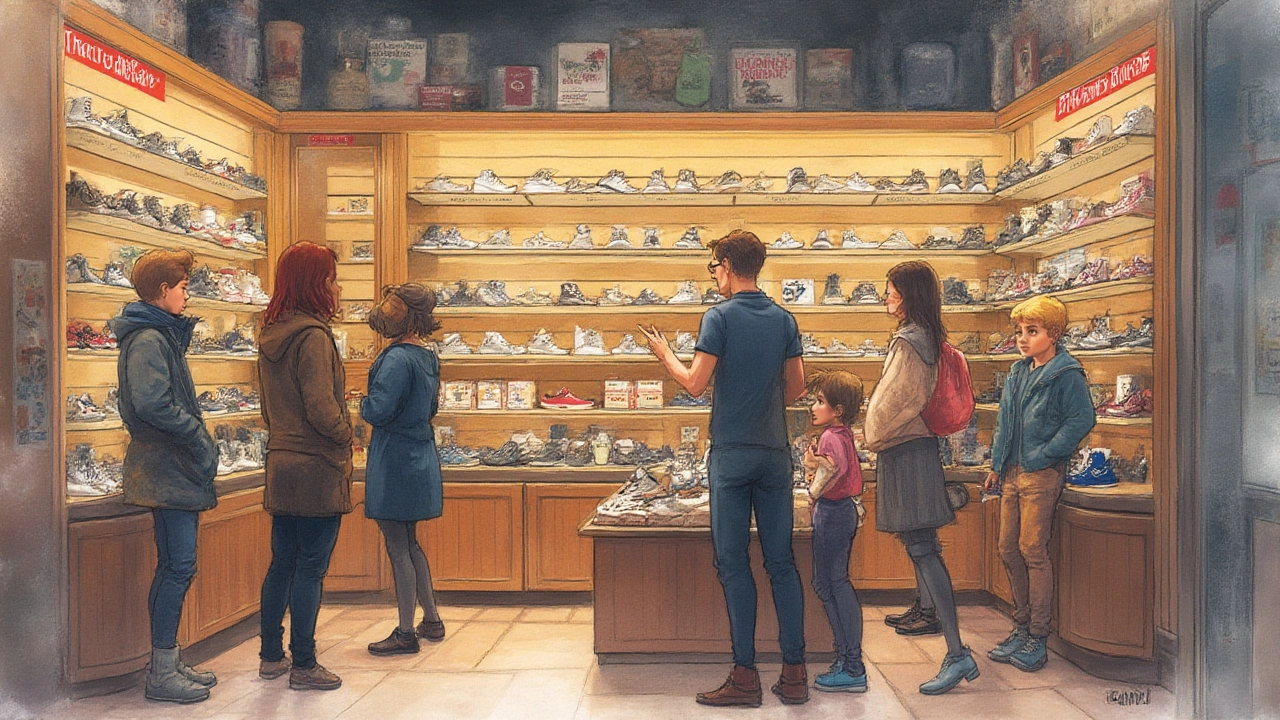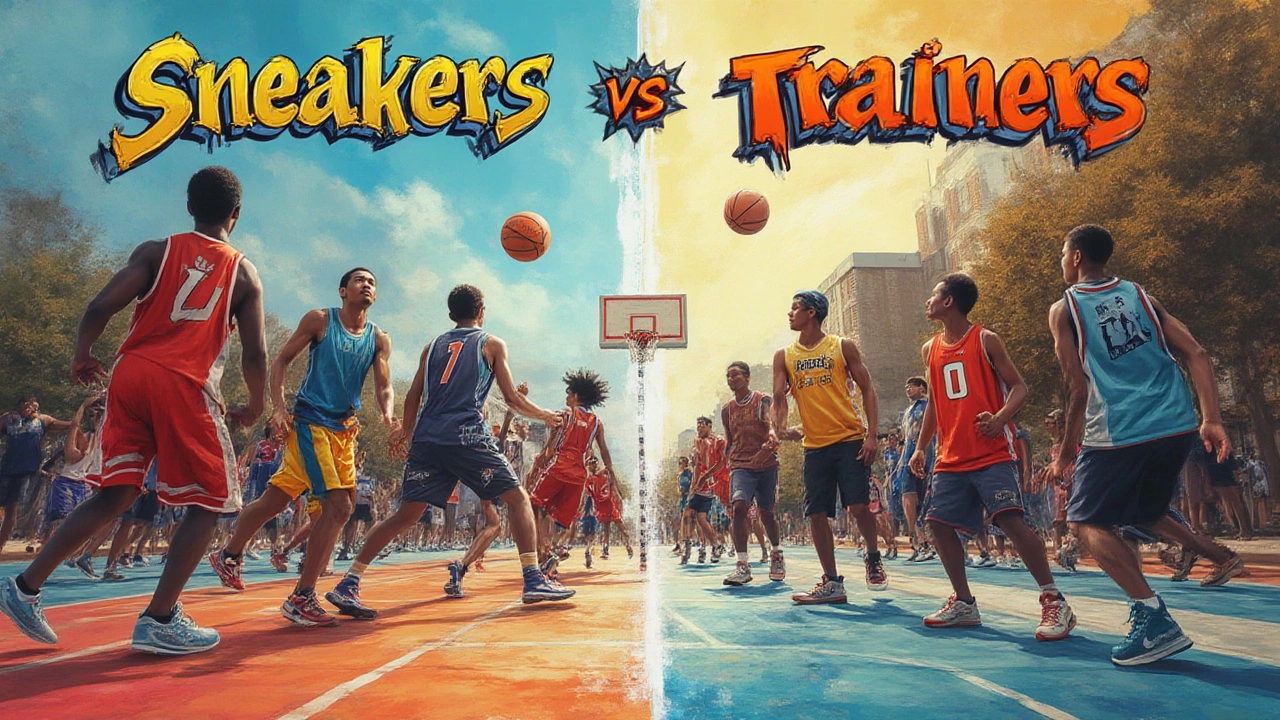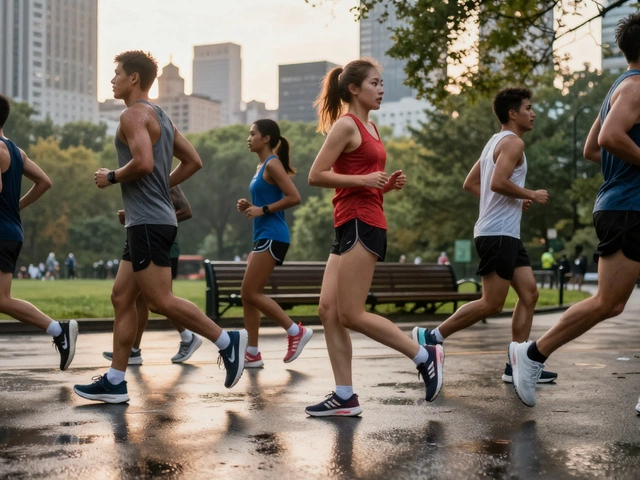Trainers vs. Sneakers: What Do Americans Really Say and Why?

- Cleo Fairchild
- 14 July 2025
- 0 Comments
It’s funny how one everyday word can draw a line in the sand between two continents. Picture yourself in a New York sneaker shop, asking for trainers—you might get some confused looks. But wander through London, say 'sneakers,' and a sales clerk will quickly steer you toward athletic shoes. The divide runs deeper than just shoes; it’s a quirky glimpse into the language gaps that can trip up conversations, travel plans, and even shopping carts.
The Classic Divide—Sneakers or Trainers?
If you’re hanging out with Americans, you just call them sneakers. That’s the word that pops up in ads, school hallways, and closets across all fifty states. Americans grew up calling any comfy, sporty shoe a 'sneaker,' whether you’re lacing up for gym class or just running errands. But the same shoes are called ‘trainers’ across the pond, especially in England and Ireland. In Australia, you might hear ‘runners,’ just to keep things interesting.
This isn’t one of those tiny language quirks that go unnoticed—it shapes what’s written on websites, the signage in stores, and what parents say to their kids before school. In a 2023 Pew Research survey, over 97% of Americans said they call them sneakers. The term ‘trainers’ barely registers, except for folks who have traveled or spent time with Brits. So, where does this word come from? American etymology traces ‘sneakers’ back to the late 1800s, when the first rubber-soled shoes let people move so quietly they could ‘sneak’ around—no joke! Meanwhile, the word ‘trainer’ caught on in the UK around the 1960s, presumably from ‘training shoes’ for athletes.
Across younger American generations, ‘sneaker’ culture is more than just the word; it’s a whole lifestyle. There are sneaker Con events, entire YouTube channels devoted to unboxing the latest Nike drop, and resale platforms trading rare Jordans for crazy sums. In the UK, the same subculture might call itself 'trainerheads,' but you’ll still hear about American 'sneakerheads' in streetwear magazines worldwide.
You can see the gap in branding, too. American brands like Converse, Vans, and New Balance plaster 'sneakers' on their US ads, but switch to 'trainers' for their European websites. This split isn’t an accidental language drift—it shapes the whole shopping experience. Ever read a fashion catalog from London and get confused by trainer and pump references? You aren’t alone!
Here’s a handy table to spell out the difference:
| Region | Common Term |
|---|---|
| USA | Sneakers |
| UK/Ireland | Trainers |
| Australia | Runners |
| Canada | Sneakers/Running Shoes |
“Language is not only a tool for communication, but a reflection of history and culture,” notes linguist Dr. Ben Zimmer in an interview with CNN. “The words we choose can draw lines about where we come from—even if we’re talking about the shoes on our feet.”
Why Do Words Matter? It’s More Than Just Semantics
Mismatched terms can mess with shopping and chatting, especially online. Let’s say you’re scrolling through Amazon.com in the US and type in ‘trainers’—rather than a wall of sporty Adidas or Nikes, you’ll probably get dog-training equipment. That’s not a weird algorithm; it’s just how deeply brands and marketplaces have embraced ‘sneakers’ in America. Swap over to Amazon UK and it’s a totally different scene; 'trainers' gets you exactly what you’d expect—those comfy everyday athletic shoes.
Ever tried discussing your favorite kicks with friends from other countries? If you’re sporting a pair of classic Chuck Taylors, you might end up in a giant debate just over what to call them. Language becomes a badge—a way of showing where you’re from, knowingly or not. Americans who study abroad or visit Europe often come back with a few new words in their vocabulary, trainers included. But for most, ‘sneakers’ sticks, even after years away from home.
Kids especially anchor to the vocabulary at home and school. In American classrooms, teachers direct kids to change into ‘gym sneakers’ for P.E. With the rise of global streaming and international travel, though, lots of Americans know what trainers are—they just don’t say it themselves unless they’re joking or chatting with someone British. Regional slang doesn’t budge easily. Even among the melting pot of big cities like New York or L.A., 'sneakers' wins every time.
These words even affect resale prices and search engine results. Try looking up ‘limited edition trainers’ from the US, and you’ll probably miss out on deals listed under ‘rare sneakers.’ Kollecting Kicks, a sneaker resale tracker, estimates that keyword mix-ups can cause 15-20% of Americans to miss finds they’d love—especially on UK or Aussie retail sites.
For anyone who shops across borders or loves digging for the latest trends, here’s a real tip: always check the local word for what you want. Want to order the hottest shoes from England? Search for ‘trainers.’ Planning a trip Down Under? Ask about ‘runners.’ It sounds simple but it can save you money—and cut down on awkward emails to customer service.

The Cultural Story of the 'Sneaker' in America
Sneakers are more than shoes in America—they’re woven into pop culture and personal identity. This goes way beyond gym class. In cities like New York and Chicago, sneakers shape street fashion and link back to hip hop and basketball. The Air Jordan wasn’t just a shoe; it was a revolution. Sneaker drops trigger lines around the block and sometimes even camping out for days to secure a pair. None of that history is tied up in the word ‘trainer’ in the US.
Watch a classic American teen movie—Ferris Bueller’s iconic white sneakers get as much camera time as his grin. Michael Jordan’s first Nike deal in the 1980s sparked a collecting craze still alive today. It’s not just athletes and rappers rocking these kicks. People working in tech, teachers, and even older adults are in on it. A University of Oregon survey in 2024 found that nearly 80% of Americans own at least two pairs of sneakers—across income levels and regions. That’s not just about comfort or fashion; it’s about fitting in, expressing personality, and even nostalgia for playground days.
The popularity also means new words spin off all the time. In American English, sneakerhead describes someone totally obsessed with collecting and learning about sneakers. There’s even a whole lingo of ‘heat’ for rare releases, ‘deadstock’ for untouched pairs, and 'grails' for the most sought-after shoes. The word ‘trainer’ just isn’t used this way in the States. Walk into a star-studded sneaker event in LA or tune in to a unboxing video, and you’ll hear sneaker a hundred times before anyone drops 'trainer.'
Even brands get in line with the lingo. American giants like Nike and Reebok build whole campaigns around sneaker culture. Release dates for new sneakers are marked on thousands of calendars. The word is so fundamental, big companies hesitate to swap in ‘trainers’ unless they're targeting the UK directly. American sneaker culture is so prominent, it’s exported to fans worldwide—sometimes people in the UK even refer to their favorite models by their American ‘sneaker’ names, especially for famous releases like the Nike Air Max or Jordan retro drops.
So next time someone asks whether Americans say trainers or sneakers, think of the wild lines for Jordans, the YouTube sneaker halls, and the city kids turning their kicks into status symbols. There’s just no other word that fits as well as ‘sneakers’ in American culture.
How to Avoid Confusion Shopping for Sneakers or Trainers
Wondering how to avoid a mix-up when you travel or shop abroad? Simple: learn the lingo before you go. Here’s a quick tip—look up the local store’s terminology online. A lot of European brands even have separate tabs for 'sneakers' and 'trainers' on their websites now, just to clear up confusion. It never hurts to ask a sales associate, either. People are usually happy to explain what they call their shoes—it's a quick icebreaker and might score you a recommendation for the comfiest pair.
When shopping online, always use the country-specific word in your searches. Filter by ‘trainers’ on British and Irish sites. Switch to ‘sneakers’ on American stores. If you love vintage kicks, search both terms—sometimes even European sellers will list American brands under ‘sneakers’ because of their popularity with collectors.
Travelers heading overseas should consider packing a little vocabulary cheat sheet for clothing and shoe terms—especially if you plan to hit big outlet malls or vintage markets. Nothing’s worse than missing a sale or buying the wrong thing because you got lost in translation. And if you’re chatting with new friends, explaining what you mean by ‘sneakers’ or ‘trainers’ can be a funny way to share stories about growing up or your favorite brands.
American expats sometimes do adjust over time. A 2022 study of frequent US-UK travelers found that about 28% start using ‘trainers’ after a couple years living abroad—but just with Brits. When they call home or talk with other Americans, ‘sneakers’ slips right back in.
If you’re a retailer or reseller hoping to reach more customers, it’s smart to tag your products with both words and mention them in your product descriptions. Google search stats show there are over five million searches monthly for 'sneakers' in the US, but 'trainers' spikes across the UK and much of Europe. Covering your bases helps customers find you, wherever they’re searching from.

Language, Culture, and Everything Your Shoes Say
This isn’t just a niche fashion question—it’s a peek at how words cross borders and influence the way we see, buy, and even love our stuff. The way Americans stick to ‘sneakers’ is as much a cultural badge as it is a language habit. It anchors whole subcultures, shows up in music, gets passed around at sneaker swaps, and shapes how brands connect with the public. While it’s easy to skip past these details, understanding them pays off when you’re shopping, traveling, or just talking fashion with new friends.
Your shoes might say a lot about your taste and lifestyle but calling them 'sneakers' or 'trainers' says even more about where you’ve been, who you’ve talked to, and how language subtly shapes identity. Next time you lace up for a run—or scroll for a new pair—think about the words you use. Chances are, they’ve walked a long way from their first steps in American gym class or British playing fields. Isn’t it funny how two syllables can map out a world?


